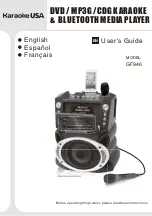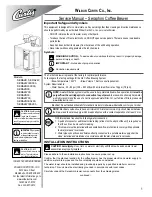
WARNING:
WARNING:
BEFORE PROCEEDING WITH REPAIRS TO
THE MACHINE READ THE INSTRUCTION
MANUAL CAREFULLY.
EXTRAORDINARY MAINTENANCE SHOULD
BE CARRIED OUT ONLY AND EXCLUSIVELY
BY EXPERT OR SKILLED ELECTRICAL-
MECHANICAL PERSONNEL.
WARNING:
ANY CHECKS CARRIED OUT INSIDE THE
MACHINE WHEN IT IS POWERED MAY
CAUSE SERIOUS ELECTRIC SHOCK DUE TO
DIRECT CONTACT WITH LIVE PARTS.
GENERAL REPAIR INSTRUCTIONS
TROUBLESHOOTING AND REMEDIES
The following is a list of practical rules which must be strictly
adhered to if repairs are to be carried out correctly.
A) When handling the active electronic components, the IGBT's
and Power DIODES in particular, take elementary antistatic
precautions (use antistatic footwear or wrist straps, antistatic
working surfaces etc.).
B) To ensure the heat flow between the electronic components
and the dissipator, place a thin layer of thermo-conductive
grease (e.g. COMPOUND GREASIL MS12) between the
contact zones.
C) The power resistors (should they require replacement)
should always be soldered at least 3 mm above the board.
D) If silicone is removed from some points on the boards, it
should be re-applied.
Use only non-conducting neutral or oximic reticulating
silicones (e.g. DOW CORNING 7093). Otherwise, silicone
that is placed in contact with points at different potential
(rheophores of IGBT's, etc.) should be left to reticulate
before the machine is tested.
E) When the semiconductor devices are soldered the
maximum temperature limits should be respected (normally
300 C for no more than 10 seconds).
F) It is essential to take the greatest care at each disassembly
and assembly stage for the various machine parts.
G) Take care to keep the small parts and other pieces that are
dismantled from the machine so as to be able to position
them in the reverse order when re-assembling (damaged
parts should never be omitted but should be replaced,
referring to the spare parts list given at the end of this
manual).
H) The boards (repaired when necessary) and the wiring should
never be modified without prior authorisation from Telwin.
I)
For further information on machine specifications and
operation, refer to the Instruction Manual.
J)
When the machine is in operation there are
dangerously high voltages on its internal parts so do not
touch the boards when the machine is live.
Every operation should be carried out in complete safety with the
power supply cable disconnected from the mains outlet and
should only by done by expert or skilled electrical-mechanical
personnel.
After completing the repairs, proceed in the reverse order to re-
assemble the cover and do not forget to insert the toothed washer
on the ground screw.
Using suitably dried compressed air, carefully clean the
components of the power source since dirt is a danger to parts
subject to high voltages and can damage the galvanic separation
between the primary and secondary.
To clean the electronic boards we advise decreasing the air
pressure to prevent damage to the components.
It is therefore important to take special care when cleaning the
following parts
Check whether dirt has been deposited on the front and back air
vents or has damaged the correct rotation of the blades, if there is
still damage after cleaning replace the fan.
-
rheofores of IGBT's Q1, Q2, Q3, Q4;
-
rheofores of recirculating diodes D40, D41;
-
rheofores of secondary power diodes D21, D22, D 23;
-
thermostat ST1 on power transformer;
-
opto couplers ISO1;
-
control board.
N.B.
WARNING!
1.0 Disassembling the machine
2.0 Cleaning the inside of the machine
3.0 Visual inspection of the machine
Fan fig. 2A
Power board figs. 2A and 2B
(
)
(
):
Make sure there is no mechanical deformation, dent, or
damaged and/or disconnected connector.
Make sure the power supply cable has not been damaged or
disconnected internally and that the fan works with the
machine switched on. Inspect the components and cables for
signs of burning or breaks that may endanger operation of the
power source. Check the following elements:
Use the multimeter to check whether the contacts are stuck
together or open. Probable cause:
-
mechanical or electric shock (e.g. bridge rectifier or IGBT
in short circuit, handling under load).
Probable cause:
-
mechanical shock.
Probable cause:
-
see main power supply switch.
If the relay contacts
are stuck together or dirty, do not attempt to separate them
and clean them, just replace the relay.
Probable cause
:
-
mechanical shock;
-
machine connected to power supply voltage much higher
than the rated value;
Main power supply switch fig. 2A
Current potentiometer R52 fig. 3
Relay K1 fig. 3
Electrolytic capacitors C4,C5, C6, C7 fig. 3
(
)
(
)
(
)
(
)
N.B.
°
- remove the current adjustment knob on the front panel of the
machine
;
- undo the 4 screws attaching the handle to the top cover (
).
-
(fig. 1)
fig. 1
undo the 8 screws fastening the back and front plastic panels;
4 for the cap (
).
- undo the 2 screws attaching the top cover to the base: 1 screw
on each side
).
- undo the 2 screws fastening the top cover to the metal
structure.
- slide out the top cover upwards
fig. 1
(fig. 1
(C7 fitted on Tecnica 152 only)
- 11 -
TECNICA 150-152-170-168GE







































